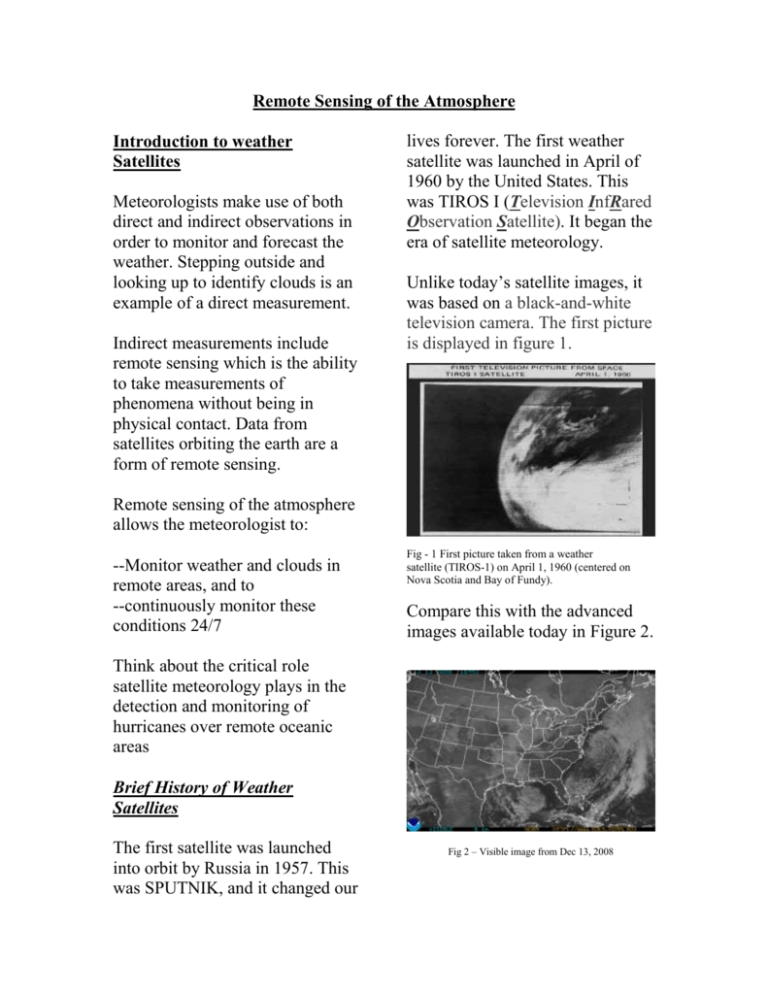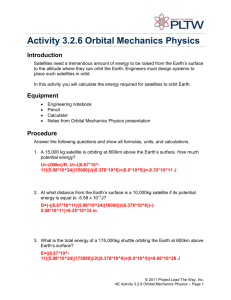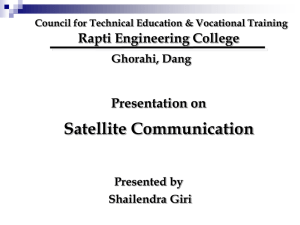Electromagnetic Radiation - Weather Satellites Background
advertisement

Remote Sensing of the Atmosphere Introduction to weather Satellites Meteorologists make use of both direct and indirect observations in order to monitor and forecast the weather. Stepping outside and looking up to identify clouds is an example of a direct measurement. Indirect measurements include remote sensing which is the ability to take measurements of phenomena without being in physical contact. Data from satellites orbiting the earth are a form of remote sensing. lives forever. The first weather satellite was launched in April of 1960 by the United States. This was TIROS I (Television InfRared Observation Satellite). It began the era of satellite meteorology. Unlike today’s satellite images, it was based on a black-and-white television camera. The first picture is displayed in figure 1. Remote sensing of the atmosphere allows the meteorologist to: --Monitor weather and clouds in remote areas, and to --continuously monitor these conditions 24/7 Fig - 1 First picture taken from a weather satellite (TIROS-1) on April 1, 1960 (centered on Nova Scotia and Bay of Fundy). Compare this with the advanced images available today in Figure 2. Think about the critical role satellite meteorology plays in the detection and monitoring of hurricanes over remote oceanic areas Brief History of Weather Satellites The first satellite was launched into orbit by Russia in 1957. This was SPUTNIK, and it changed our Fig 2 – Visible image from Dec 13, 2008 Note the sharper resolution of cloud elements and features in today’s imagery. The cellular cloud structure in the Atlantic (off the Mid-Atlantic coast) is evident as well as in the central Gulf of Mexico (figure-2). Types of Weather Satellites There are two (2) primary types of weather satellites. The first is the Geostationary Operational Environmental Satellite or GOES. The other satellite program is the Polar Operational Environmental Satellite or POES (frequently referred to as the Polar Orbiter). The diagram below (Figure 3) shows the relationship of the orbits of these two different weather satellite systems (GOES and POES). The details of the orbits are described below. GOES satellite system The GOES system orbits the earth at an altitude of 22,300 miles (36000 km) at the rotational speed of the earth. Since it is fixed over the same line of longitude over the equator, it has a defined field of view. Thus it continuously transmits images of the same portion of the earth below it (see student activity later in module). The United States maintains 2 GOES satellites. They cover the eastern and western US respectively, as well as portions of both the Atlantic and Pacific Oceans. The European nations maintain a system (METEOSAT) to cover Africa, Europe, the eastern Atlantic and western Indian Oceans. The Japanese maintain the GMS system to cover Asia, Australia, and the western Pacific and eastern Indian Ocean. The India Meteorology Department also maintains satellite INSAT) coverage over India and the Indian Ocean. Fig – 3 Orbits of the POES and GOES satellite systems POES satellite system There are 2 polar orbiting weather satellites or POES. These weather satellites orbit the earth from pole to pole at a much lower altitude than their GOES counterparts. Typical orbital altitude is approximately 900 km. Compared to the fixed field of view of GOES, the Polar Orbiter collects data in a swath beneath its orbit as it tracks from pole to pole around the earth. The trip from one pole to the other takes about 100 minutes. Since the earth rotates below the POES, the weather satellite sees the entire earth twice in a period of 24 hours. These image swaths are pieced together to create a mosaic. In summary, the POES weather satellites provide better spatial resolution than GOES since they orbit the earth at a much lower altitude. However, the tradeoff for the enhanced spatial resolution is lower temporal resolution (i.e. less frequent coverage of the same area) than GOES. Student/teacher activity Why do the satellites orbit at the altitudes they do? Consider Newton’s first law of gravity (in relationship to GOES satellite altitude) : F = (G) * (m1 m2)/(r²) G=universal gravitational constant 6.673 x 10-¹¹ Nm² / kg² m refers to the mass of body #I (satellite 2105kg) and body #2 (earth 5.988x1024 kg) r = distance or altitude F = gravitational force in this case 649 N (N=newtons) Thus r² = (G) * (m1m2)/( F) r² = (6.673x10 -¹¹)(2105)( 5.988x1024) / 649 r = (84111.430 x 1013 / 649) ½ r = (12.96 x 1014) ½ r = 3.6x104 m or 36000km Dealing with the units of measure is a scientific nicety but also critically important for confirming the measurements so the satellite doesn’t crash: (Nm² /Kg²) (Kg) (Kg) / N = m² Since we are taking the square root to get the value of r, we are left with meters (m) which is easily converted to kilometers (km). Equipment onboard Weather Satellites Remember, the theory behind satellite imagery and interpretation involves the measurement of electromagnetic radiation emitted or reflected from the earth’s surface, oceans and atmosphere. Cameras are not used on today’s satellites. Two primary types of instruments are used today: 1. Imagers or Radiometers, and 2. Vertical Atmospheric Sounders. Imagers or Radiometers There are two types of imagers (radiometers). One measures the visible light spectrum reflected back, while the other one measures IR radiation emitted back to the satellite. Information from these radiometers is transmitted to earth where computers convert the data into Visible and IR images. Vertical Atmospheric Sounders The other type of equipment onboard the satellite is the Vertical Atmospheric Sounder or VAS. While not covered in this module, it allows for vertical soundings of the atmosphere. These soundings are similar to those constructed from the cricketsonde launched at Milton High School (Oct 2008). The VAS profiles include vertical plots of temperature, pressure, water vapor and other atmospheric gases. Summary The visible picture is simply a representation of what we would see with our eyes if we were aboard the satellite. The visible image is a measure of the visible portion of the EM spectrum. The IR image depends upon the amount of IR radiation emitted by the earth-atmosphere system and detected by the satellite’s radiometers. The IR imagery allows continuous (24/7) monitoring of the earth-atmosphere system which is why the IR imagery is critically important and complements the visible imagery. Satellite imagery provides a varied amount of information to both the operational and research communities in the atmospheric sciences. Clues about current weather conditions allow the meteorologist to have enhanced confidence in short range weather forecasts. Data from the satellites allow us to monitor the earth-atmosphere system over the long term, noting changes in the earth’s hydrosphere and atmosphere (e.g. the oceans, lakes and ice caps). These changes are both feedback from, and impact on, any climatic changes underway.









